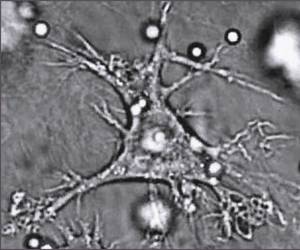Scientists have discovered where HIV hides out in the body, highlighting an important target for future therapies and solving a long-standing puzzle about where the virus goes even when levels in the blood fall to undetectable levels.
 Writing in this month's Journal of Virology, Brigham Young University researcher Greg Burton and his colleagues studied tissue samples from AIDS patients and showed that one of the immune system's key orchestrators, the follicular dendritic cell (FDC), which has the job of presenting foreign material to the other components of the immune system, can hang on to intact HIV particles and keep them intact for months if not years. By binding onto the virus particles in this way the FDCs paradoxically protect and preserve the virus in an infectious form which can subsequently re-infect other vulnerable cell types when they pass by.
Writing in this month's Journal of Virology, Brigham Young University researcher Greg Burton and his colleagues studied tissue samples from AIDS patients and showed that one of the immune system's key orchestrators, the follicular dendritic cell (FDC), which has the job of presenting foreign material to the other components of the immune system, can hang on to intact HIV particles and keep them intact for months if not years. By binding onto the virus particles in this way the FDCs paradoxically protect and preserve the virus in an infectious form which can subsequently re-infect other vulnerable cell types when they pass by.
By testing samples collected from patients over an extended period of time the team were able to compare the genetic sequences of viruses harboured by their FDCs when they died, with viruses that were present at different times during their illnesses. The results show that the cells are effectively archiving samples of the patient's viruses over an extended time period, which has important implications for future treatments designed to flush HIV out of the bodies of infected individuals.
So why should these cells do something so apparently self-destructive? The team think that FDCs store samples of what is challenging the body in order to enable them to regularly remind the immune system what it needs to respond to. When we're vaccinated, for instance, the material in the vaccine is probably dispensed a small amount at a time, to help to maintain a robust and long-lasting immune response. Unfortunately, HIV has evolved a strategy to exploit this immunological loophole and turn it to its own advantage. "If we could go in and perhaps flush it from the surface of the cells, we might decrease dramatically the amount of virus that could perpetuate infection," says Burton.










Comments
Add a comment